Physical Address
304 North Cardinal St.
Dorchester Center, MA 02124
Physical Address
304 North Cardinal St.
Dorchester Center, MA 02124
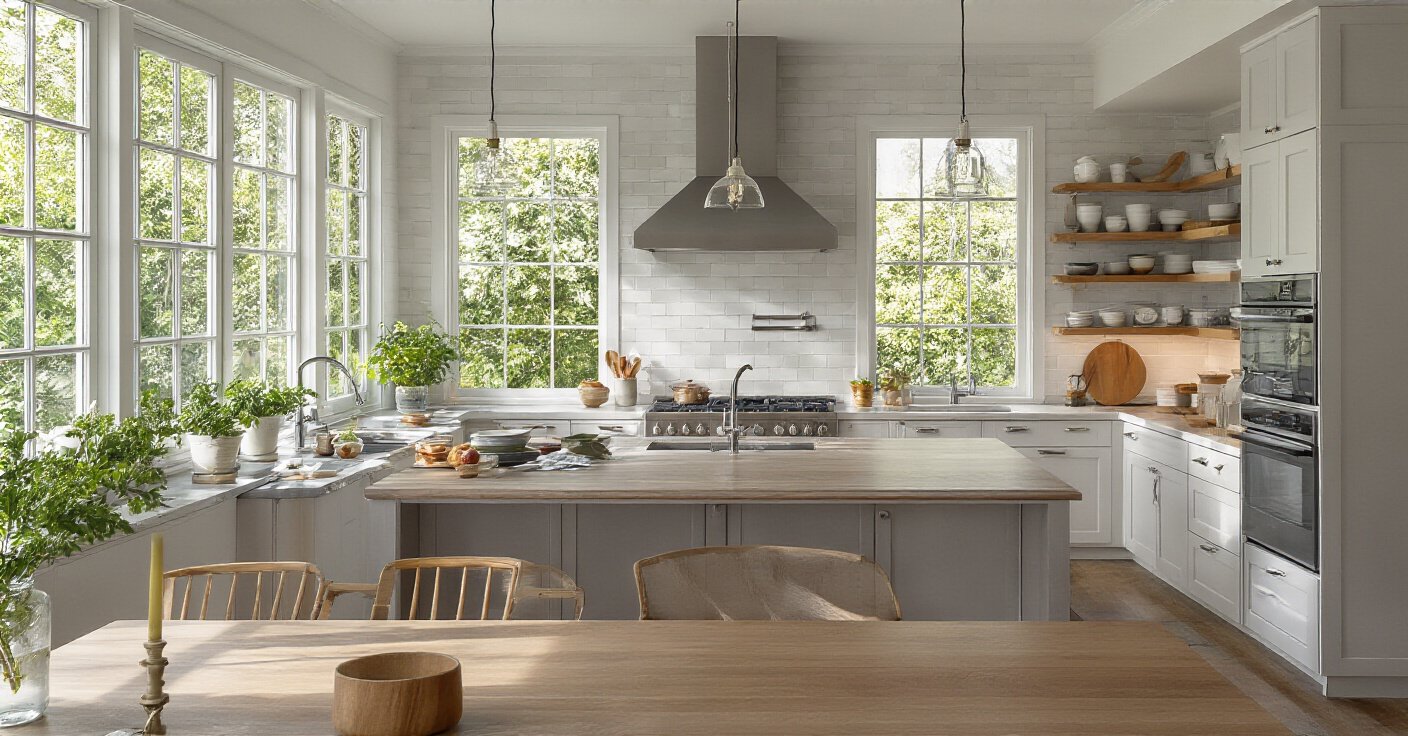
A designer's guide to a multi-generational kitchen. Discover 21 real-life lessons for creating a space that honors culture, family, and harmony for years to come.
Can we talk for a minute about those perfect, pristine white kitchens you see all over social media? The ones with a single, artfully placed lemon on an immaculate marble island. Everyone seems to think that’s the goal. But here’s what I’ve learned from years of designing for real, complicated, wonderful families: for a home with kids, grandparents, and clashing cultural traditions, that picture-perfect kitchen is a nightmare waiting to happen. It’s beautiful, but it’s not useful.
A kitchen isn’t a museum piece. It’s the bustling, sometimes messy, always-beating heart of your home. It’s where your mother-in-law teaches your kids to make dumplings, where you unload a week’s worth of groceries, and where your teenager makes a monumental mess creating a smoothie. Your kitchen needs to be a bridge, not a barrier. It has to serve everyone, from the person who needs a walker to the toddler who needs a snack. Forget the trends for a minute. Let’s talk about what actually matters.
Before we even think about a backsplash tile or a fancy faucet, we have to talk about the soul of the kitchen. This is the part everyone wants to skip, but it’s the only part that guarantees you’ll love the space in five years, not just for five minutes. It’s about understanding the people, the budget, and the deep-down feeling you want to create.
You know what people always ask me? “What’s the best kitchen layout?” And I always say, “I have no idea until you tell me how you live.” It’s not about some one-size-fits-all “work triangle.” It’s about observing the dance of your family. Who does the cooking? Is it one person, or a team? I had a client once where the grandmother, who lived with them, used two woks for everything, while the husband was an avid baker. A standard Western kitchen layout would have been a daily frustration for them. We had to create zones—a powerful wok station with heavy-duty ventilation, and a separate, lower counter for kneading dough.

The biggest mistake is designing for an aspirational life you don’t actually lead. You plan a huge, elaborate kitchen for the five-course dinner parties you think you’ll host, when in reality, you need a streamlined space for getting kids fed and out the door on a Tuesday morning. Be honest. Does your family live on microwaved meals and takeout, or do you simmer bone broth for days? The answer dictates everything. My shortcut? For one week, keep a lazy journal of every single thing that happens in your kitchen. Note the traffic jams, the things you can’t find, and the messes. That journal is your blueprint.
Once you know how your family moves, you can start putting a number on the dream.
Let’s get real about money. A kitchen renovation is one of the most expensive projects you can take on, and it’s where dreams go to die if you don’t have a brutally honest plan. The noise is all about the high-end appliances and designer finishes. What actually matters is allocating your money to solve your biggest problems first. Is your biggest problem a lack of storage? Then your money goes to clever cabinetry, not a fancy six-burner stove you’ll only ever use two burners on.

I learned this the hard way on one of my first projects. The family fell in love with a stunning, imported marble countertop. It was their “must-have.” They stretched the budget to get it, which meant they had to skimp on everything else—cheap cabinet hardware, a basic fridge, and not enough lighting. A year later, the marble was stained and etched because they have three young kids, the flimsy drawer pulls were breaking, and the room felt dark. They’d spent a fortune to be unhappy. The shortcut? Allocate a 15% contingency fund before you even start. Things will go wrong. Old plumbing will be discovered. A wall you thought was fine will need to be reinforced. That 15% isn’t “extra,” it’s a mandatory part of the budget.
With a real budget in hand, now we can talk about the fun part—the look and feel.
Everyone tells you to just get on Pinterest and start pinning. That’s a recipe for disaster. You end up with a board full of a hundred different styles—a little modern farmhouse here, a little sleek industrial there—and no clear direction. The result is a kitchen that looks like it got dressed in the dark. Instead of collecting pictures of kitchens, I tell my clients to think about a feeling. How do you want to feel when you walk into the room? Calm? Energized? Cozy?
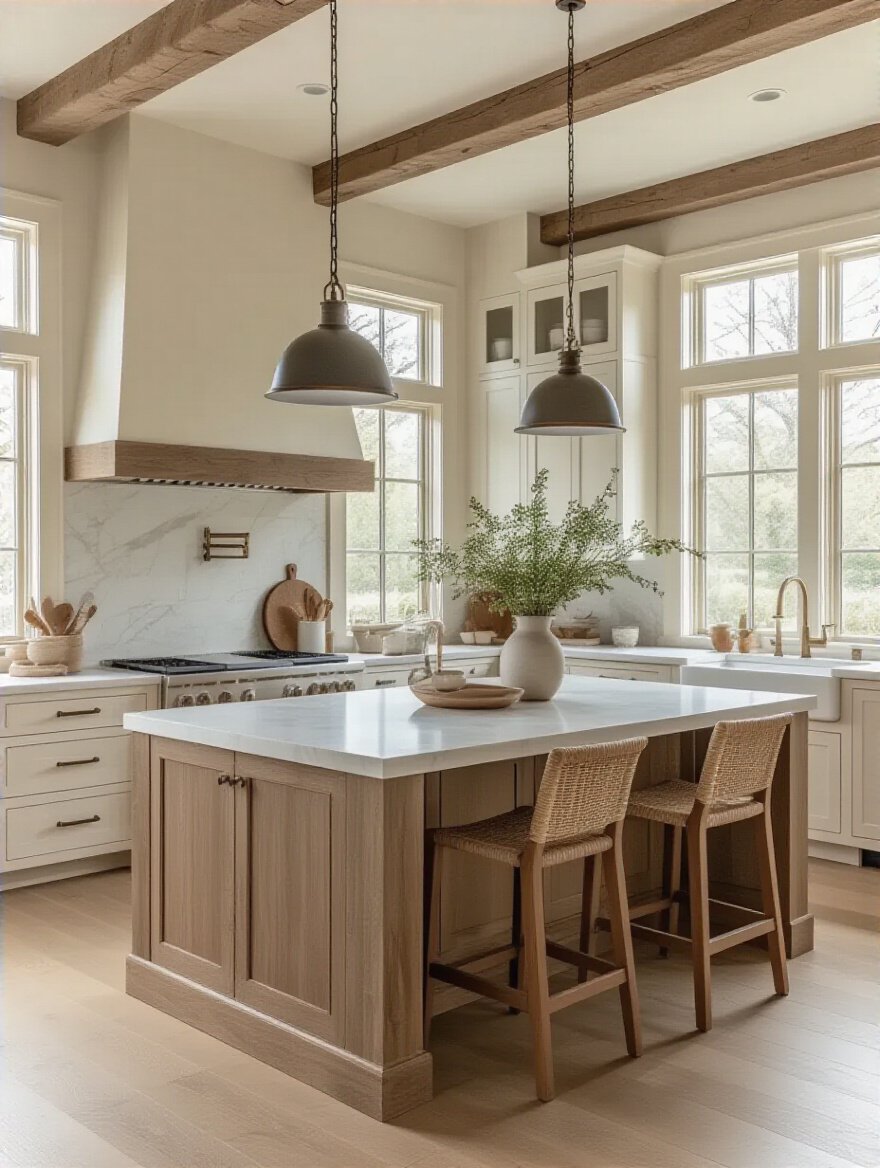
One family I worked with was blending two very different cultures—one minimalist Scandinavian, the other warm and vibrant Indian. A purely minimalist kitchen would feel cold to half the family, and a purely vibrant one would feel cluttered to the other. Their “core aesthetic” wasn’t a style name; it was a feeling: “peaceful sanctuary with joyful energy.” That became our filter. We chose clean-lined Shaker cabinets (peaceful) but in a deep, welcoming sapphire blue (joyful). We used simple hardware but incorporated a backsplash with a subtle, intricate pattern. You see? It’s not about picking a label; it’s about creating a personal rulebook.
Now that you have a “feeling” to aim for, you can start gathering ideas that actually serve that vision.
Okay, now you can go on Pinterest. But don’t just look at kitchens. That’s how you end up with the same kitchen as your neighbor. The most soulful homes pull inspiration from completely unexpected places. Look at fashion for color combinations. Look at nature for textures. Look at a boutique hotel you loved for its lighting and mood. Your kitchen doesn’t have to look like a kitchen showroom; it should look like you.
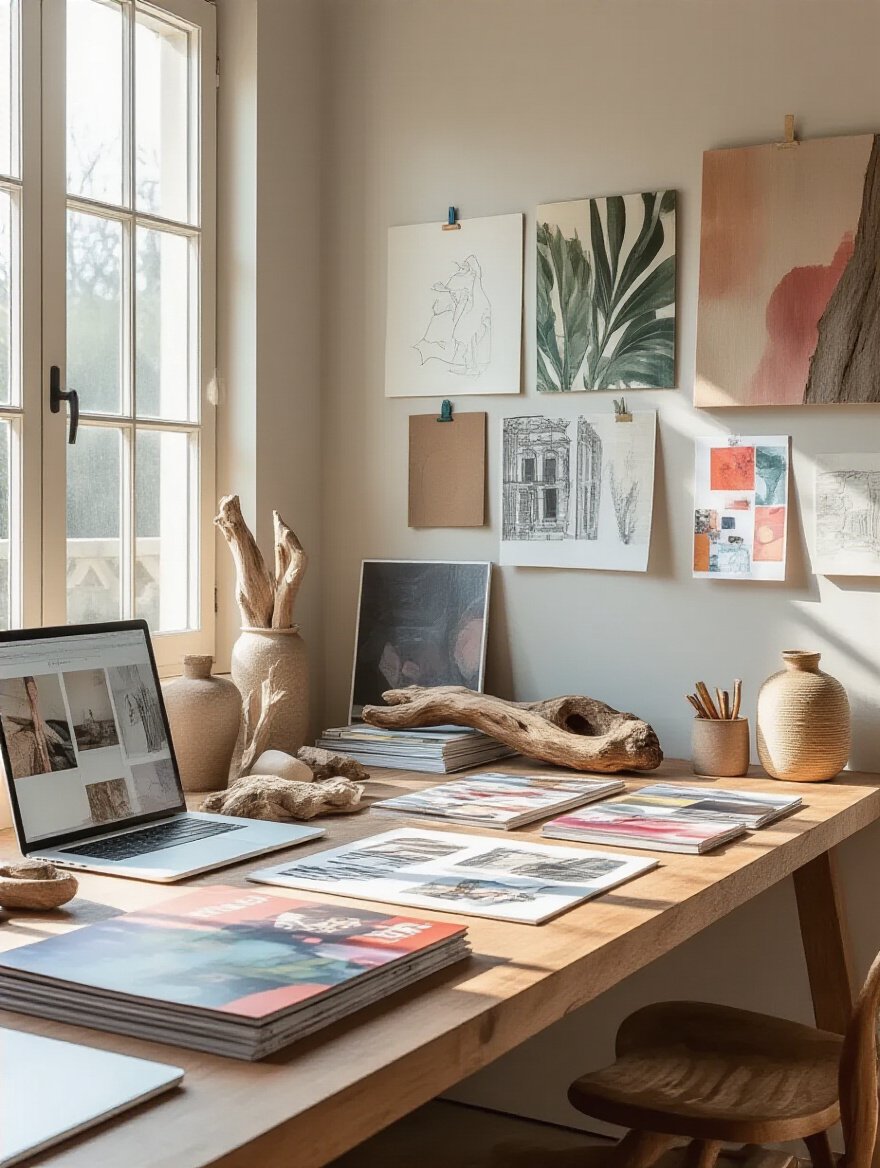
I had a client who felt uninspired by every kitchen photo she saw. During our conversation, she mentioned a trip to Morocco that she and her husband took years ago. Her face lit up when she described the courtyards—the feel of the rough plaster walls, the geometric tiles, the deep indigo blue. We barely looked at another kitchen photo after that. We found a tile for her backsplash that had that handmade, geometric feel. We used a special plaster-like finish on the walls. Her kitchen doesn’t scream “Morocco,” but it feels like that memory. It feels personal and full of soul, and it’s completely unique.
Once your head is full of these big, beautiful ideas, we need to bring them back down to earth and see what your house will actually let you do.
Picture this: you’re standing in your current kitchen, sledgehammer in hand, ready to take down that wall that’s always bugged you. Stop. Just stop. I once watched a client get halfway through demolishing a wall before they realized it was holding up the master bathroom. The cost to fix that mistake was eye-watering, and it derailed their project for months.
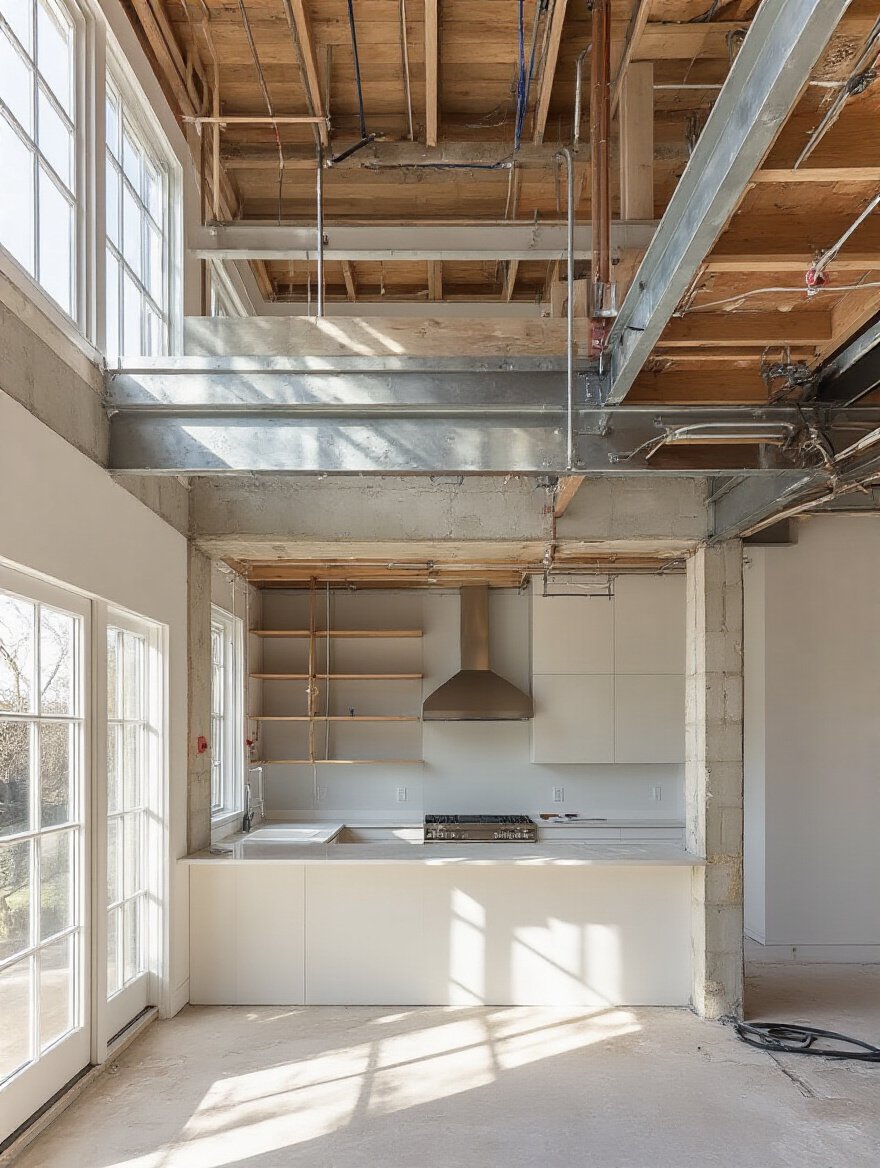
Before you fall in love with any specific open-concept plan, you have to bring in a professional—a good contractor or a structural engineer—to tell you what your house is made of. Where are the load-bearing walls? Where is the main plumbing stack? Where are the HVAC runs? These are the boring, non-negotiable truths of your home. You can’t just wish them away. Knowing this stuff upfront doesn’t limit your creativity; it focuses it. It forces you to come up with clever solutions instead of just throwing money at impossible dreams. It’s the difference between a smart, feasible plan and a financial disaster.
This is where your kitchen gets its personality. You’ve done the deep thinking, and now you get to choose the things you’ll touch and see every single day. The key here is balancing beauty with the reality of your life. Every choice should serve the family, not just the aesthetic.
Can we have a heart-to-heart about countertops? Everyone swoons over the dramatic veining in natural marble, and it is beautiful. But if you have kids who spill grape juice or a partner who leaves coffee rings everywhere, marble will become your enemy. It stains and etches if you so much as look at it wrong. For most families, especially multi-generational ones, the real luxury isn’t a fancy material—it’s peace of mind.
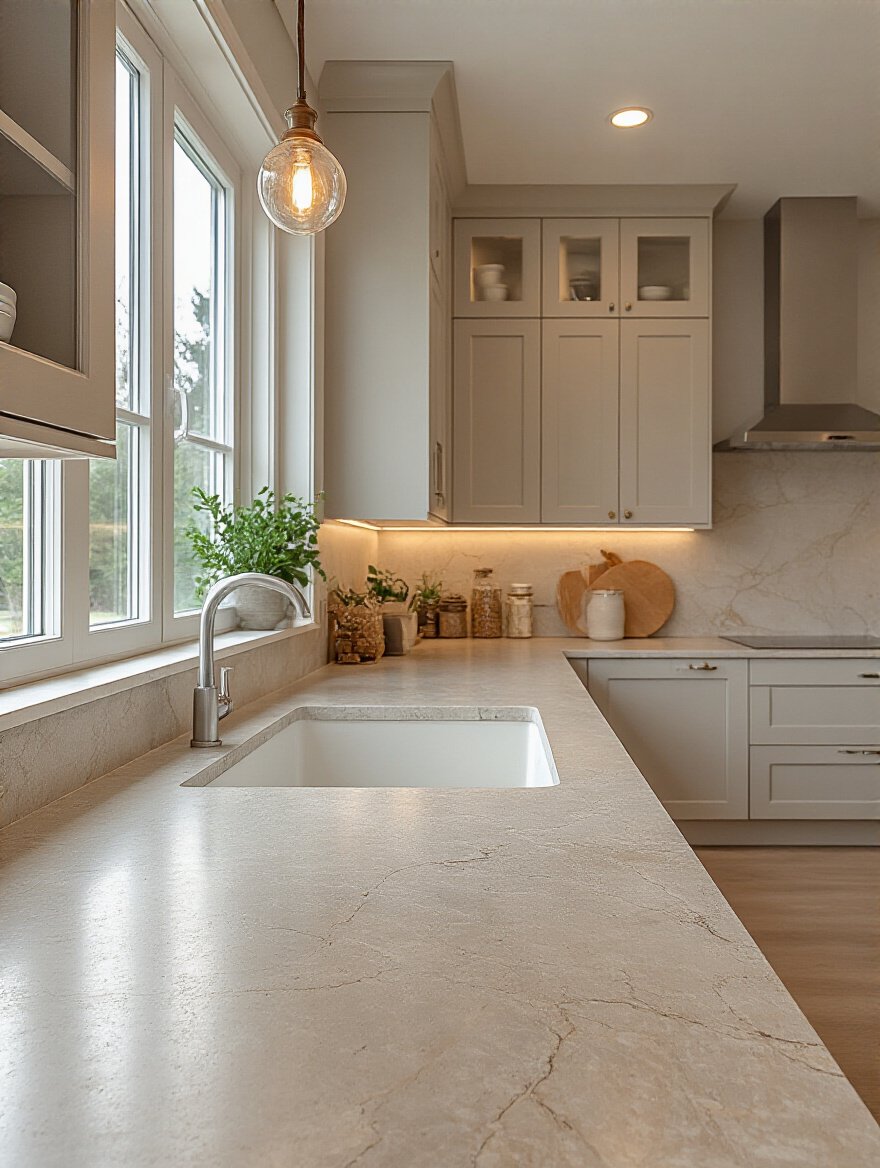
You want something that doesn’t make you gasp in fear every time someone sets down a glass. Engineered quartz is my go-to for busy families. It’s practically bomb-proof. You can spill wine, turmeric, lemon juice—it just wipes clean. It gives you the look of natural stone without the anxiety. A great shortcut here is to get samples of your top choices and abuse them. Leave a wet tea bag on them overnight. Try to scratch them with your keys. See what survives your real life, not what looks good in a showroom. That’s how you make a choice you won’t regret.
The countertops set the stage, but the cabinets are the main characters.
The cabinets are the bones of your kitchen. They take up the most visual real estate and they’re the most expensive thing to replace, so you want to get them right. Everyone else will tell you to follow the trends—ultra-glossy, no-hardware cabinets one year, rustic dark wood the next. Ignore them. The smartest money is on timelessness. For me, that’s almost always a Shaker-style door.
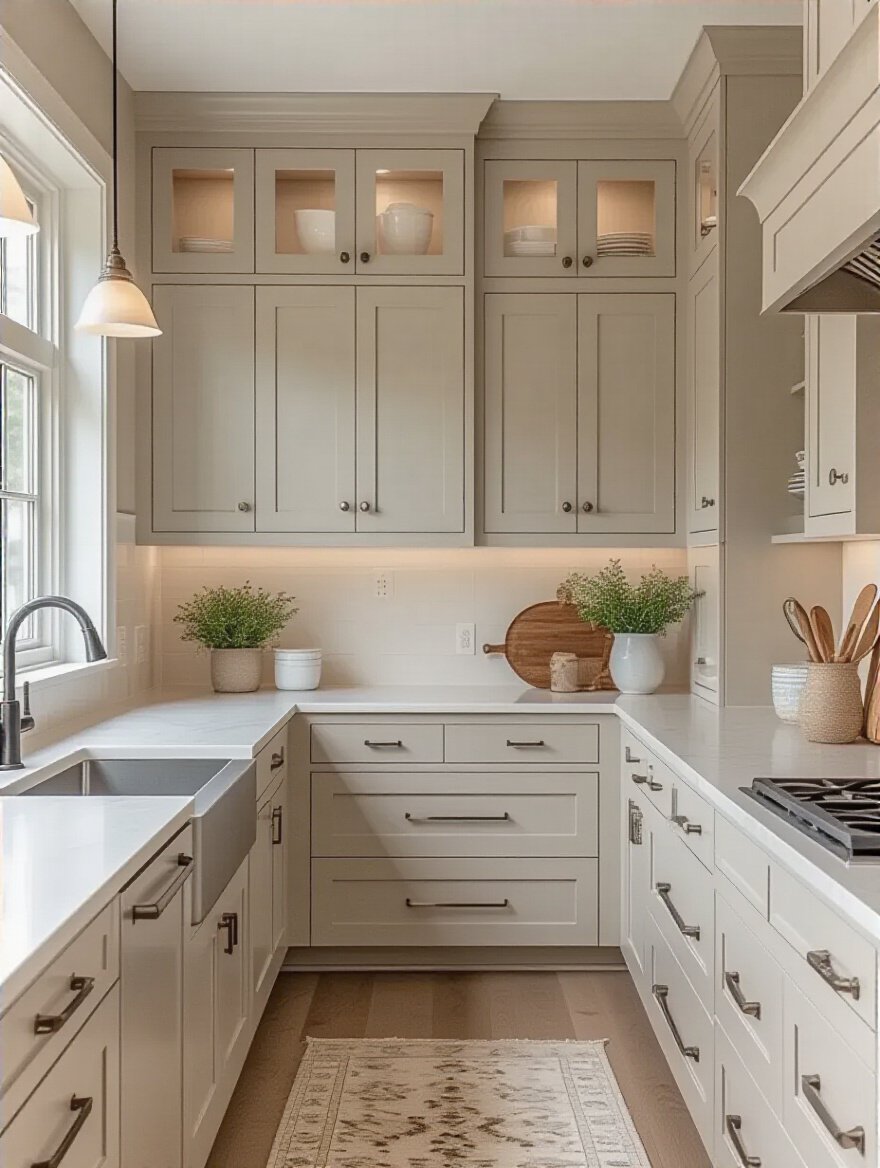
It’s a chameleon. I’ve used Shaker cabinets in hyper-modern homes and traditional farmhouses. With different hardware and colors, it adapts. It’s a clean, classic design that respects both Eastern and Western aesthetics and won’t look dated in five years. And please, for the love of all that is holy, choose drawers over lower cabinets wherever you can. Deep drawers for pots and pans are a game-changer. No more getting on your hands and knees to find that one lid at the back of a dark cupboard. It’s a small detail that makes a kitchen more accessible for someone with a bad back and less frustrating for everyone else.
Once your cabinets are set, the next thing you walk on every day is your floor.
Your kitchen floor has the hardest job in the entire house. It gets splattered with grease, covered in crumbs, and deals with more foot traffic than any other surface. Choosing the right one is a dance between beauty, comfort, and sheer toughness. So many people fall for gorgeous hardwood, but in a kitchen, it can be a constant source of worry about water damage and scratches.
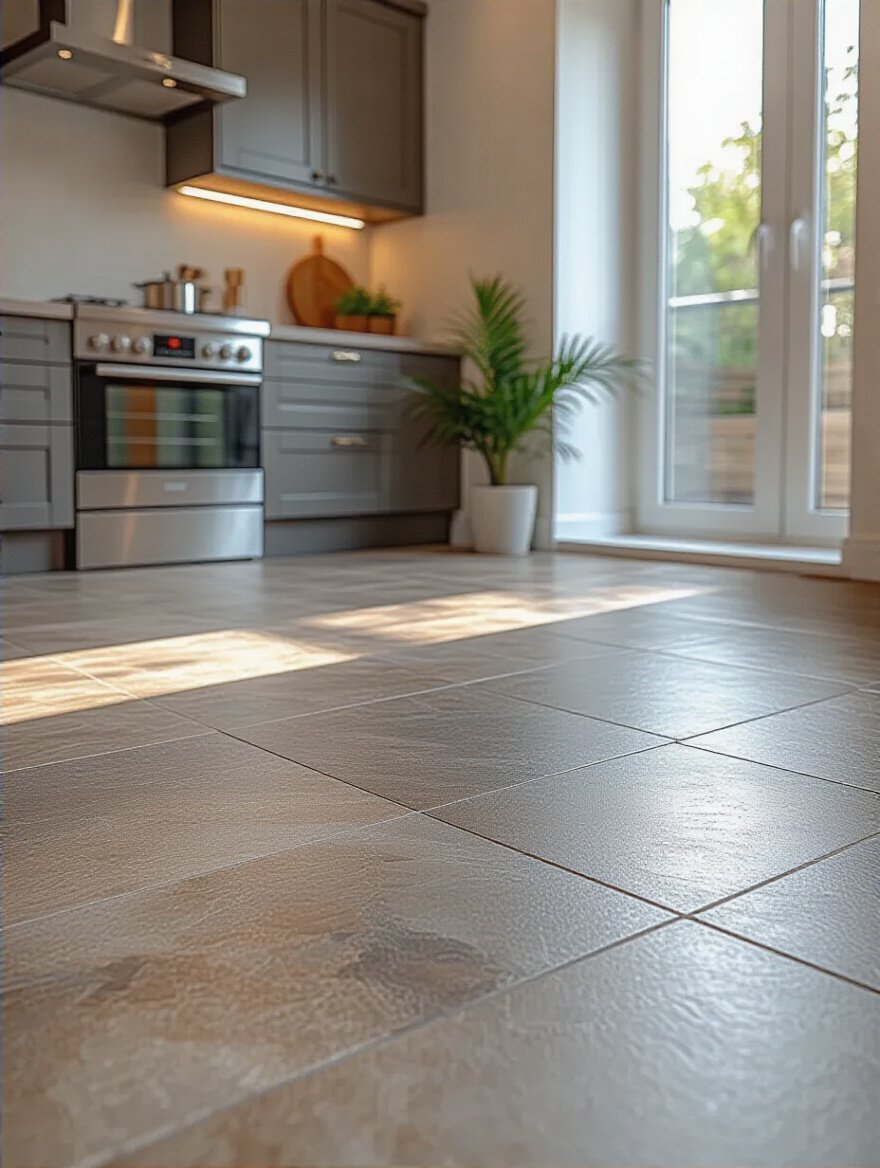
I’m a huge fan of Luxury Vinyl Plank (LVP) for family kitchens. Don’t cringe—this isn’t your grandma’s peeling linoleum. Modern LVP looks uncannily like real wood or stone, but it’s waterproof, scratch-resistant, and much softer underfoot, which is a big deal if you spend hours on your feet cooking or have an elderly parent living with you. I had a client with three kids and two large dogs who were adamant about hardwood. I convinced them to try LVP in the kitchen, and a year later, they thanked me. After countless spills and muddy paw prints, it still looked brand new, and they never had to worry about it.
With the foundation of the floor laid, we can add a bit of jewelry with the backsplash.
The backsplash is your chance to play. If your cabinets and countertops are the sensible, timeless outfit, the backsplash is the statement necklace or the colorful scarf. It’s a relatively small area, so you can afford to be a bit bolder here without it overwhelming the space or breaking the budget. It’s the perfect place to inject personality and culture.
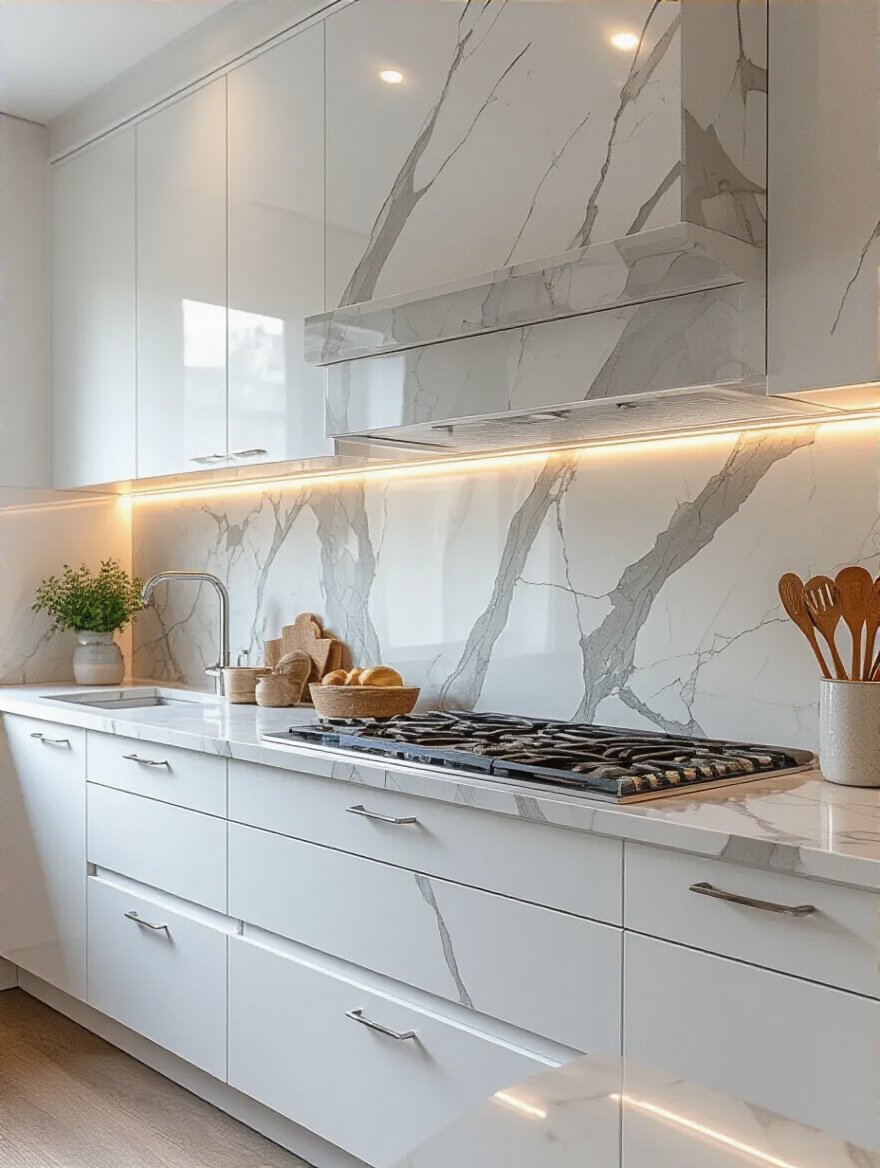
I once worked with a family from Portugal who had a beautiful collection of hand-painted tiles. They were too delicate for a floor, but we integrated them into the backsplash behind the stove. It became this incredible, personal focal point that told a story about their heritage. The rest of the kitchen was simple and modern, but that one feature gave it so much soul. The common mistake is just picking a basic subway tile and calling it a day. It’s fine, but it’s a missed opportunity. Look for a texture, a unique shape, or a color that makes your heart sing.
That pop of color from the backsplash is a great starting point for thinking about the entire palette.
Paint is the cheapest, most effective way to completely change the feeling of a room. But people get paralyzed by the thousands of color chips at the hardware store. The secret isn’t to find the “perfect” color in a vacuum; it’s to find the color that pulls everything else together. Your paint has to flatter your cabinets, your countertops, and your flooring.

My shortcut for this is to look at the undertones in your fixed elements. Does your granite countertop have little flecks of warm gold or cool gray in it? Pull one of those colors out for your walls. A common mistake is picking a wall color with a cool, blue undertone when your cabinets have a warm, yellow one. It will just feel off, and you won’t know why. Always, always, always get sample pots and paint large swatches on your walls. A color looks completely different in your home, with your lighting, than it does on a tiny paper chip under fluorescent store lights.
Now we get into the nitty-gritty of how the kitchen actually works. This is all about the geometry of movement. A beautiful kitchen that is frustrating to cook in is a failure. We want to create a space that feels intuitive and effortless, whether you’re making a solo cup of tea or hosting a huge family feast.
The classic “work triangle”—the path between the sink, stove, and fridge—is a concept that’s been around for a hundred years for a reason: it works. The idea is to keep these three key points close enough to be efficient, but not so close that you’re tripping over yourself. The noise you’ll hear today is that the triangle is “outdated” for modern kitchens. That’s BS. It’s not outdated; it’s just evolving.

In a large kitchen, or one where multiple generations cook at the same time, we don’t just have one triangle; we might have multiple zones. Think of it as a main triangle for the primary cook, with a smaller “prep triangle” at the island with a second sink, or a “baking zone” with the ovens and mixer clustered together. What matters is that the paths between your most-used stations are clear and unobstructed. I once saw a gorgeous kitchen where a massive, clunky island was plopped right in the middle of the path from the fridge to the sink. It looked amazing in photos, but making a simple salad was a five-point turn. Function first, always.
This principle of flow is most critical when you don’t have a lot of space to work with.
I have a soft spot for small kitchens. They force you to be clever and intentional, and a well-designed small kitchen can be more efficient than a sprawling one. In a small space, every single inch has to work for a living. The key is to think vertically and to embrace smart, multi-functional solutions.

Go for cabinets that stretch all the way to the ceiling. You can store lesser-used items (like the turkey platter) up high. Use appliance garages to hide the toaster and coffee maker, keeping your precious counter space clear. Choose narrow-depth appliances designed for smaller spaces. I worked on a tiny apartment kitchen for a young couple, and my favorite trick was a custom pull-out cutting board right above the trash can. You chop, then just sweep the scraps directly into the bin below. It was a simple, space-saving feature that they said made a huge difference in their daily routine.
The best way to make any kitchen, big or small, feel more functional is to banish clutter.
Your countertops are for working, not for storage. But life is messy, and things accumulate. A truly smart kitchen doesn’t just have a lot of storage; it has the right kind of storage in the right places. It anticipates your needs. Before you design your cabinets, do a full inventory of your kitchen stuff. Where will the giant stand mixer live? Where will you store your spices so you can actually see them?

My all-time favorite storage solution is deep drawers with dividers. You can store plates, bowls, even pots and pans in them. They are so much more accessible than deep lower cabinets. Another game-changer is a dedicated pull-out pantry. Instead of a deep closet where things get lost in the back, the shelves pull out to you, so you can see everything at a glance. It’s an absolute must for families, and it means you won’t buy a third jar of paprika because you couldn’t find the first two. These things cost more upfront, but the daily satisfaction they bring is priceless.
The undisputed champion of adding both storage and workspace is the kitchen island.
An island can be the “village square” of your kitchen. It’s where kids do homework, where guests gather with a glass of wine, and where you lay out a buffet for a party. But a poorly planned island can be a disaster—a huge obstacle that ruins your workflow. The most common mistake I see is making it too big for the space. You need at least 42 inches of clearance around it for a comfortable walkway. Anything less and the kitchen feels cramped.

If you have the space, an island is the perfect place to add a second sink for food prep, which is a lifesaver when two or more people are cooking. It’s also a great spot for the microwave drawer, keeping it off the main counter and at a good height for both kids and adults. One of my favorite designs for a family was a two-level island. The lower, counter-height level faced the stove and was the dedicated work zone. The slightly higher bar-height level faced the family room, providing a casual spot for seating that kept the kids close, but safely out of the main cooking area.
Okay, the bones of your kitchen are strong. The layout works. Now it’s time for the final layer that makes it all sing. This is the stuff that adds mood, character, and a sense of completeness. Don’t treat these as afterthoughts; they are essential.
This is my biggest pet peeve: kitchens with just one sad, lonely ceiling light in the middle of the room. It’s the worst. It casts shadows on your countertops exactly where you need to see what you’re chopping. A good kitchen needs layers of light, just like a good room needs layers of texture. You need three types: ambient, task, and accent.

Ambient is the overall glow, your recessed lights or ceiling fixture. Task is the bright, focused light for your work areas—this is your under-cabinet lighting, and it is non-negotiable. It will change your life. Accent is the pretty stuff, like a beautiful pendant over the island or a small light inside a glass-front cabinet. Put them all on dimmers. This way, you can have bright, clear light when you’re cooking, and then dim everything down for a soft, warm glow when you’re relaxing with a cup of tea. It makes the room work for every mood and every time of day.
Once you have great lighting, you’ll want to highlight the beautiful hardware and fixtures.
Cabinet pulls and faucets are the jewelry of the kitchen. They are small, but they have a huge impact on the final look. This is a place where you can get a lot of bang for your buck. You can have simple, affordable cabinets, but if you put beautiful, high-quality hardware on them, the whole kitchen instantly looks more expensive and custom.

Think about the user experience. For a home with an elderly parent, chunky bar pulls are much easier for arthritic hands to grip than tiny, dainty knobs. A pull-down faucet is a functional workhorse that makes rinsing vegetables or filling a big pot a breeze. Don’t be afraid to mix metals, but do it with intention. A good rule of thumb is to keep your main “plumbing” fixtures (faucet, pot filler) in one finish, and your “cabinetry and lighting” in another. For example, a matte black faucet with brushed brass pulls and pendants can look incredibly chic and purposeful.
Hardware shines brightest when it’s reflecting natural light.
You can’t buy a light bulb that even comes close to replicating the beauty of natural daylight. It makes colors look truer, makes spaces feel bigger, and just plain makes people feel happier. Before you start planning your kitchen, look at where the light comes from in your house. Can you make a window bigger? Can you change a solid back door to one with glass panels?

If you have a dark, interior kitchen with no access to windows, a “solar tube” or “sun tunnel” can be an amazing solution. It’s a reflective pipe that funnels natural light from your roof down into the room. I’ve seen them completely transform dark, gloomy kitchens into bright, cheerful spaces. Also, think about reflection. Glossy backsplash tiles, polished countertops, and even the finish on your appliances can help bounce natural light around the room, making it feel brighter and more alive.
And the final piece of the puzzle is the color that ties it all together.
We’ve touched on this, but it’s worth repeating: paint is your final unifying element. The right color will make your cabinets look richer, your countertops pop, and the whole space feel harmonious. The wrong color will make everything look slightly “off.” The secret is to choose your paint color last. I’ve seen so many people do it the other way around, and it’s a mistake.

You can get paint mixed in literally any color imaginable, but your countertop and cabinets are fixed. So, pick those expensive, hard-to-change items first. Then, take a drawer front and a countertop sample to the paint store with you. Find a color that speaks to the undertones in those materials. Then, take a sample pot home and live with it for a few days. See how it looks in the morning light, in the afternoon, and at night under your artificial lights. It’s a bit of extra work, but it will save you from the regret of painting an entire room the wrong shade of beige.
Your kitchen is planned, built, and beautiful. This final step is about breathing life into it. It’s about integrating technology that makes your life easier and adding the little touches that tell your family’s unique story.
This is the most important part. This is what turns a house into a home. A perfectly designed kitchen with no personality is a sad, sterile place. Your kitchen should tell the story of your family. Frame your kid’s messy, wonderful artwork. Display your grandmother’s old recipe box. Put a collection of mismatched mugs from your travels on an open shelf.

One of my favorite clients had a narrow, otherwise useless wall in her kitchen. We installed shallow, floating shelves and she used it to display her growing collection of ceramic bowls made by local artists. It didn’t add much storage, but it added immense joy and character. It became a living gallery of her passion. Don’t strive for perfection; strive for connection. The little imperfections, the meaningful objects, the things that hold memories—that’s the stuff that gives a home its soul.
Beyond the soulful touches, modern kitchens can also have a brain.
Look, I’m not talking about a fridge that tells you you’re out of milk. For me, smart technology is about practical support for busy families. Think of a smart oven that you can preheat on your way home from soccer practice. Think of a stove with an automatic shut-off feature that gives an older, more forgetful family member more independence and you more peace of mind. That’s technology that serves a real human need.

Voice-activated lighting is another one I love for families. When your hands are covered in dough or you’re carrying a sleeping child, being able to just say, “Hey Google, turn on the kitchen lights,” is a small but meaningful luxury. The key is not to get carried away with gimmicks. Focus on a few smart devices that solve a specific problem for your family. A strong Wi-Fi signal is the foundation for all of this, so make sure your kitchen isn’t a dead zone before you start investing in smart appliances.
Finally, let’s build a kitchen that’s not just good for your family, but good for the world.
Building a sustainable kitchen isn’t about being trendy; it’s about making smart, healthy, long-term choices. It means choosing materials that don’t off-gas toxic chemicals into the air your family breathes. It means choosing appliances that use less energy and water, saving you money on your utility bills every single month.

This can be as simple as choosing low-VOC (Volatile Organic Compound) paint and making sure all your new appliances are ENERGY STAR certified. It can also be about choosing durable, timeless materials that you won’t want to rip out in five years, reducing waste. One of the best sustainable choices you can make is to design for longevity. A kitchen that is well-built, functional, and beautiful will serve your family for decades, and that is the truest form of sustainability there is.
So, there you have it. Designing a kitchen is a huge undertaking, but it doesn’t have to be overwhelming. At the end of the day, it’s not about slavishly following rules or trends. It’s about a series of thoughtful conversations and choices. It’s about asking, “How will this serve the people I love?”
If you focus on that question—on creating a space that is forgiving, functional, and full of your family’s unique spirit—you can’t go wrong. You’ll build a kitchen that isn’t just a place for making meals, but a place for making memories. And that’s a beautiful thing to come home to.